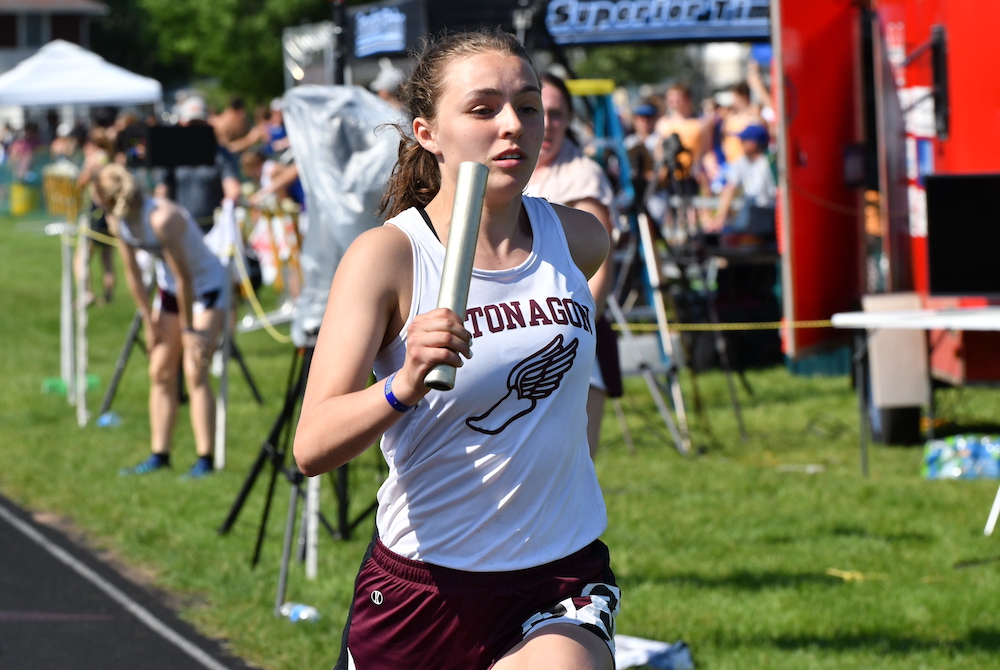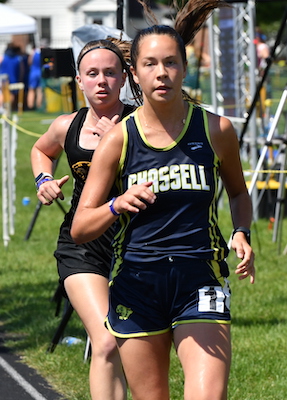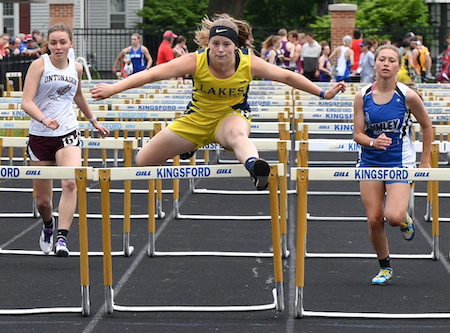
Ontonagon Girls Hit Fastest Stride at Championship Time
By
John Vrancic
Special for MHSAA.com
June 6, 2021
KINGSFORD — A season of steady improvement paid off for the Ontonagon girls track & field team Saturday as the Gladiators earned their first Upper Peninsula Division 3 Finals title in five years with 73 points.
They were followed by Rudyard with 64 and Stephenson with 54½.
“It was great,” said coach Brian Amos. “It was one of those seasons which was full of surprises. The girls just kept getting better. Surprisingly, in our first meet on a cold and rainy day in Ironwood (Kraemer Invitational), they started looking smooth. Their performance speaks for itself.”
Sophomore Lilly McIntyre won the 100-meter dash in a personal-best 13.7 seconds and classmate Makennah Uotila took long jump with a personal-best leap of 16 feet on a hot and humid day.
 “I had a pretty good start in the 100,” said McIntyre. “The warm weather helped. I didn’t have to spend so much time getting warmed up.
“I had a pretty good start in the 100,” said McIntyre. “The warm weather helped. I didn’t have to spend so much time getting warmed up.
“This is a big confidence builder. We had the best handoffs we had all year (in the 800 relay).
The Gladiators won that race in one minute, 55.25 seconds and the 1,600 relay (4:33.36).
Uotila added runner-up finishes in the 400 and 800 with personal-best times of 1:04.41 and 2:32.81, respectively.
“Those are tough races, especially with short recovery times in between,” she said. “I just try to pace myself for all events. Sixteen feet in long jump was my goal all season. I’m very excited.”
Rudyard sophomore Tristin Smith took the 400 (1:04) and was runner-up in the 1,600 (5:40.69).
“I try to start fast and stride it out,” said Smith. “It’s really good to have this competition, and it feels great to work hard all year and take a first up here. I had the second-fastest qualifying time. I knew I had a chance.”
Emma Bogacki added a first for the Bulldogs in discus (100-5).
Stephenson’s lone first came in pole vault where Daisy Grinsteiner cleared nine feet.
Mid Peninsula senior Daisy Englund won the 800 in a season-best 2:30.75 and was runner-up in the 100 (13.93).
“It’s such a hot day, and we never had competition like this,” said Englund, who will run at Ferris State next season. “I didn’t want to get boxed in. With 200 meters to go, I knew I had to kick it in. It was a relief to win the 800.”
 Junior teammate Landry Koski, seeded eighth going into the 1,600, came from behind to win in a season-best 5:39.89, followed by Smith, Bessemer sophomore Natalie Stone (5:42.82) and Ewen-Trout Creek senior Elise Besonen (5:44.82).
Junior teammate Landry Koski, seeded eighth going into the 1,600, came from behind to win in a season-best 5:39.89, followed by Smith, Bessemer sophomore Natalie Stone (5:42.82) and Ewen-Trout Creek senior Elise Besonen (5:44.82).
“This is my favorite race,” she said. “I knew I had to beat two girls to place. I knew about Gwen Kangas (of Chassell), but I didn’t know about the girl from Bessemer. When I saw they were in the 5:40s, I knew I had to pick it up. After the first 800 I felt I had a chance, and with the Rudyard girl right next to me (during the final lap), I knew I had to kick it in.”
Kangas anchored the winning 3,200 relay, which was clocked in 11:09.64, and won the open 3,200 (12:58.8) followed by Besonen (13:14.38) and Koski (13:22.85).
“I just stayed positive,” she said. “Doing cross country helps quite a bit with all that running and conditioning. It’s just a matter of making sure you’re hydrated. We knew it was coming. You just have to prepare for this.”
Lake Linden-Hubbell took the 400 relay (54.7), edging Brimley by three tenths of a second, and freshman Abi Codere won the 100 hurdles in a personal-best 17.16.
“I think I had a good start,” said Codere. “It felt like my form was good. This is a big confidence builder and a good learning experience. I never expected this, but after one of our home meets, our coach told me I may have a chance.”
Pickford junior Lucy Bennin took the 200 (28.66), edging North Dickinson junior Ashton Hord by 11 hundredths of a second, and Lizzie Storey captured the 300 hurdles (51.59).
“I had a pretty good start in the 200 and really kicked it in at the end,” said Bennin. “I poured a glass of water on myself before the start, and it felt real good. That gave me a little bit of a cool down before the race. After looking at the forecast, we knew it’d be hot and it helped me prepare mentally.”
Ellie Delene provided Baraga with a first in high jump (4-11) and Jaylyne Lindemann won shot put (32-8), tossing an inch further than Republic-Michigamme’s Leah McCracken.
PHOTOS: (Top) Ontonagon's Nicole Lukkari anchors the 1,600 relay Saturday. (Middle) Chassell's Gwen Kangas, right, is followed by Ewen-Trout Creek's Elise Besonen in the 3,200. (Below) Lake Linden-Hubbell's Abi Codere, middle, wins the 100 hurdles. (Photos by Cara Kamps. Click to see more at RunMichigan.com.)

Hastings Relays Reigns as State's Oldest Continuous Track & Field Meet
By
Steve Vedder
Special for MHSAA.com
April 10, 2024
Bob Branch remembers dabbling in other sports, but his first love was always running.
 The Hastings High School graduate admits he could never hit a baseball, football didn't especially appeal to him and basketball was just another way to spend time with friends. But for Branch, now 93, there was always track. That's the sport where his fondest and sharpest memories remain. And if you're talking track, many of his favorite memories come from participation in the state's oldest continuous track meet, the Hastings Relays.
The Hastings High School graduate admits he could never hit a baseball, football didn't especially appeal to him and basketball was just another way to spend time with friends. But for Branch, now 93, there was always track. That's the sport where his fondest and sharpest memories remain. And if you're talking track, many of his favorite memories come from participation in the state's oldest continuous track meet, the Hastings Relays.
Always held in early April, the meet dates back to 1937 – a bygone time that saw the first hostilities of World War II, gas at 20 cents a gallon and a loaf of bread selling for a dime.
And at a dusty old track surrounding the county fairgrounds in Hastings, a small relay event that included a scattering of participants from a dozen high schools was taking its first tentative steps.
Branch recalls a time when kids would run home after track practice because there were no buses, inexperienced young coaches had little actual knowledge of running fundamentals, and athletes looked at the sport as an afterthought after spending most of their high school days playing football and basketball.
 For Branch, the relays were the ideal way to ease into the track season.
For Branch, the relays were the ideal way to ease into the track season.
"I just liked to run," said Branch. "I remember I anchored a relay with my brother, and it always seemed cold when we had that meet. I remember teams would come from all over and you saw a lot of good athletes. Everybody seemed to have someone who was really good. Track wasn't very popular at that time, but I have a lot of good memories from running."
The Hastings Relays, which has changed formats and even names during its nearly nine-decade history, would traditionally kick off the track season. The meet was originally held at a makeshift quarter-mile track which surrounded the town's fairgrounds and was part of the city's annual Hastings Carnival – the track would become the midway during fair time.
The meet eventually moved to Johnson Field when the football field was dedicated in 1949 and ballooned to as many as 50 teams at its peak in 1957. For more than seven decades it was known as the Hastings Relays and then the Hastings Co-Ed relays before becoming the current Hastings Invitational, with the latest edition scheduled for Friday.
Johnson Field had a cinder track before it became an all-weather surface in the 1980s. During a time long before computers would be used to organize meet heats in mere minutes, Hastings coaches of all sports – defined as "volunteers" by the athletic department – would meet on the Friday before competition to hash out events.
People associated with the meet still recall the camaraderie built on those long Friday nights, followed by working what would often become 10-hour meets. Steve Hoke has been involved since watching his father, Jack, who coached teams at 15 of the meets beginning in 1951 and also had run in the first Hastings Relays. Steve Hoke later competed in the Relays as well during the early 1970s before becoming an assistant track coach, later the Hastings athletic director and now a volunteer worker.
"It was always a huge deal," said Hoke, who said the meet began as a pure relay event before transitioning to its current team format in the 1990s. "I remember we'd line the track the night before, and all the coaches would come to the house to organize everything. There was a brotherhood.”
 If you quiz many of the fleet of volunteers who've worked the relays over the years, each has a different memory from the meet. While Hoke describes the brotherhood and Branch the outstanding competition, others remember weather and the time a thunderstorm wiped out the line markings on the cinder track, or waking up to find three inches of snow that caused a rare cancellation of the meet. Others recall the shock of moving from the cinder to all-weather track or using the meet as an early measuring stick of what it would take to qualify for the state meet. The real old-timers remember the meet disappearing for three years during World War II.
If you quiz many of the fleet of volunteers who've worked the relays over the years, each has a different memory from the meet. While Hoke describes the brotherhood and Branch the outstanding competition, others remember weather and the time a thunderstorm wiped out the line markings on the cinder track, or waking up to find three inches of snow that caused a rare cancellation of the meet. Others recall the shock of moving from the cinder to all-weather track or using the meet as an early measuring stick of what it would take to qualify for the state meet. The real old-timers remember the meet disappearing for three years during World War II.
Hastings native and Western Michigan grad Tom Duits was the state’s second collegian to break the four-minute mile when he ran a 3:59.2 at a meet in Philadelphia in 1978. Duits, who ran in three Hastings Relays, was in line to join the U.S. Olympic team in 1980 before the United States pulled out of the games due to tension with Russia.
Duits has his own memories of the meet and the competition he faced there.
"I remember sunshine and being excited to be competing again. There were all these athletes swarming around; it was an awesome display of talent," he said. "It was always one of the best meets we'd be in. You could pretty much see the level of runners who would be at state, which made it a big deal. It was always early, but you could tell where you stood. It was great exposure."
Hastings track star Wayne Oom competed in four Hastings Relays from 1984-87. One of his sharpest memories was the difference between running on a raw cinder track versus the far more comfortable all-weather surface.
"Those cinders would grind into your skin," said Oom, part of the Hastings school record in the two-mile relay. "But I think it helped us because when we'd go to other tracks, it seemed we would run faster. I remember how competitive it was, especially in the distances. There were some great runners."
While participants have their unique memories, so do coaches. Former Saxons coach Paul Fulmer remembers 2008 when his team finished first on the boys side of the meet while his wife, Grand Haven coach Katie Kowalczyk-Fulmer, saw her girls team win the championship.
 "I knew we were one of the favorites to win because we were usually near the top of our conference and Regional," he said. "But then Katie's team was pretty good, and it was cool for them to win too."
"I knew we were one of the favorites to win because we were usually near the top of our conference and Regional," he said. "But then Katie's team was pretty good, and it was cool for them to win too."
Fulmer, who coached Hastings from 1978-81 and then 1985-2010, said at least part of the meet's popularity was derived from a unique way of scoring. Instead of individuals earning points solo, participants worked in pairs. For instance, two athletes would combine their shot put or long jump scores. New events such as the 1,500 relay and sprint medley were added.
"We had a tradition of being the state's oldest meet, and that was a big deal," Fulmer said. "And we ran a good relay; that attracted teams too. We took a lot of pride in that.
"And we'd get quite a lot of people to come to the meet. We'd set up until like 9 or 10 p.m., and then we'd have a party with all the coaches on Friday night."
While the meet has stretched 87 years, Branch said early participants and current runners have one thing in common: a drive to win. Branch ran in an era when the popularity of high school track was in its infancy. Today some of the best all-around athletes at a school are involved in the track program. The relays span the nearly nine decades in between.
"The quality of teams has gotten better and better," said Branch, the 1947 Lower Peninsula Class B Finals champ in the 220. "And this has made for a better meet. We would get guys who played football or baseball kind of drift into track, and that made the sport better. I think people began to appreciate track because we'd get teams from all over.
"We went from not really knowing what we were doing to track being a good sport. Even then, I'm not sure we appreciated what we had. We really liked the Hastings Relays and always wanted to do well there. It became popular and quite an honor to do well. Those are the kind of things I remember."
PHOTOS (Top) Racers run at the Hastings Relays, with several more awaiting their turns to compete at the longtime meet. (2) The author wrote on the 50th anniversary of the Relays for the Hastings Banner nearly 40 years ago. (3) Past athlete, coach and athletic director Steve Hoke shows some of the Relays awards from the 1930s. (4) Tom Duits was one of the state’s biggest track stars of the 1970s and ran in three Hastings Relays. (Top photo by Dan Goggins, Hoke photo provided by Steve Hoke and Duits photos provided by Tom Duits.)

